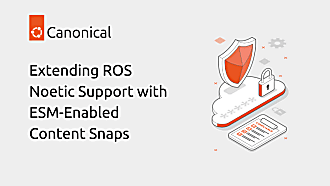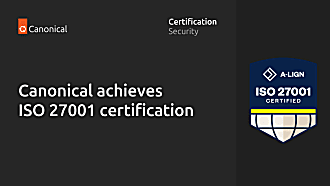David Beamonte
on 15 June 2022
What you’re missing out if you don’t try Ubuntu Core 22

Ubuntu Core is the operating system for IoT and edge
Ubuntu Core, the Ubuntu flavour optimised for IoT and edge devices, has a new version available. With a 2-year release cadence, every new release is both an exciting and challenging milestone.
Ubuntu Core is based on Ubuntu. It is open source, long-term supported (LTS), binary compatible and offers a unified developer experience. It allows developers and makers to build composable and software-defined appliances built from immutable snap container images. The goal is to offer developers a new development experience, getting away from complex cross-compilation frameworks and intricate system layers Application development is the focus with simple tools that can be used across all Ubuntu flavours.
Ubuntu Core 22 is fully containarised and secure
Its fully containerised architecture offers a new embedded operating system paradigm which is inherently reliable and secure. Applications are completely isolated from each other and the system, creating systems that are extremely robust and fault-tolerant. It has been designed for devices with constrained resources, and optimised for size, reliability, performance and security.
Security is a major concern for unattended and connected devices, so security features have been carefully designed to offer peace of mind to the most paranoid of IT managers.
- With Full disk encryption, Ubuntu Core ensures data and system integrity, encrypting the partition using digital signatures that are stored in hardware TPM.
- Secure Boot protects against vulnerabilities at boot time, verifying system integrity with a hardware root of trust.
With 4 releases behind, Ubuntu Core is a mature embedded operating system. It has been widely adopted by both enterprises and the community, as it successfully solves many of the key challenges IoT and edge devices makers must face. Ubuntu Core 22 sits on the base of those strengths, offering new features that increase the scope of usability.
Why you should be excited about UC22
There are many features that should make you feel excited about the new Ubuntu Core 22 release. Discover the most relevant ones in the following sections or check the full list of features:
Migration and backward compatibility
One of the key properties of Ubuntu Core 22 (UC22) is that it maintains the same partition layout as Ubuntu Core 20 (UC20). This is really important, as it provides a path to upgrade UC20 systems to UC22 and backward compatibility of the new features to UC20.
LTS alignment
Ubuntu Core 22 is based on Ubuntu 22.04 LTS; the release has been deliberately aligned with that version (released on 21 April 2022). This allows Ubuntu Core 22 to be fully supported for the whole life of 22.04 LTS (until 2032).
Performance improvements
IoT and embedded devices usually have limited storage, memory and CPU resources. This is why, with every new release of Ubuntu Core, there are always improvements in all of these areas. In Ubuntu Core 22, both footprint and memory usage have been optimised and reduced. The same is true for boot time and snap execution time.
Remodelling
An Ubuntu Core image is characterised by its model assertion. This model assertion contains identification information (such as brand account id and model name), the essential system snaps (including the gadget snap, kernel snap and the boot base snap), other required or optional snaps that implement the device functionality and additional options for the defined device, such as the security grade and encryption of the image.
Remodelling is a new feature that allows changing any of the elements of the model assertion. Brand, model, IoT App Store ID or version are some of the contexts that can be changed, enabling resellers to rebrand devices. This is also a necessary feature for having a migration path between UC20 and UC22.
Validation-sets
A validation set is an assertion that lists specific snaps that are either required to be installed together or are permitted to be installed together on a device or system. It allows applications to be updated consistently and simultaneously towards well defined and predictable revisions. This increases the compatibility and consistency between applications.
Factory reset
With the factory reset feature, you can restore an Ubuntu Core device to a known pristine state, preserving essential data created during initialisation. Although it was possible to perform this action with previous Ubuntu Core versions, it was a tedious and manual task. Ubuntu Core 22 includes a factory reset boot mode, accessible from run and recovery modes.
Quota groups
A quota group sets resource limits on services inside the snaps it contains. Currently, maximum memory and CPU usage are supported as resource limits.
MAAS support
MAAS is Metal As A Service, a service that treats physical machines like virtual machine (instances) in the cloud. It provisions a full system image remotely for bare-metal hardware. Now, it is possible to deploy Ubuntu Core 22 to bare-metal devices in the field using MAAS.
Ubuntu Core 22 Webinar invitation

Save your seat for our first episode of our webinar series: Introduction to Ubuntu Core 22 on June 28th, 2022 at 4:00PM CET.
In this webinar, you will learn:
- Everything you need to know about Ubuntu Core
- What are the new and exciting features of Ubuntu Core 22
- Why Ubuntu Core 22 is the embedded operating system chosen by many key players
Get started with UC22
Getting started with Ubuntu Core 22 is very easy and straightforward. If you use pre-certified hardware then you just need to:

Ubuntu Core has pre-built images for many popular platforms. Explore our list of supported platforms or contact us. You can also start a project from scratch for your custom board following our simple guides.
Stay tuned

Join us at Embedded World to see exciting demos (June 21-23rd, 2022 in Nuremberg, Germany
Further reading
- Official press release
- Explore some of the most important Ubuntu Core features: https://ubuntu.com/core/features
- Watch the new Ubuntu Core 22 video



